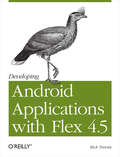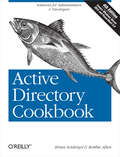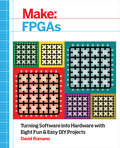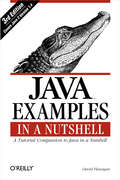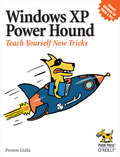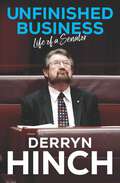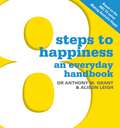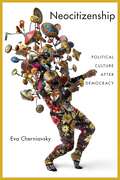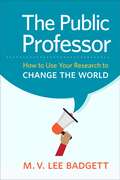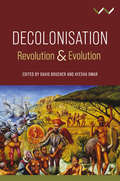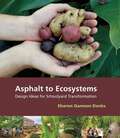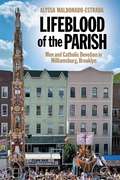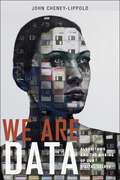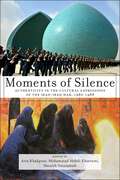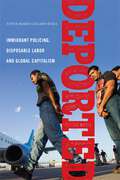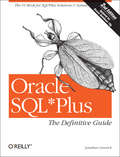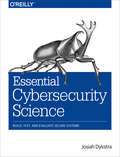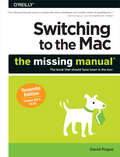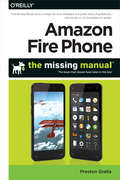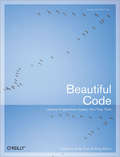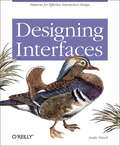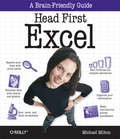- Table View
- List View
Developing Android Applications with Flex 4.5: Building Android Applications with ActionScript
by Rich TretolaReady to put your ActionScript 3 skills to work on mobile apps? This hands-on book walks you through the process of creating an Adobe AIR application from start to finish, using the Flex 4.5 framework. Move quickly from a basic Hello World application to complex interactions with Android APIs, and get complete code examples for working with Android device components—GPS, camera, gallery, accelerometer, multitouch display, and OS interactions. No matter how much Flex experience you have, this book is the ideal resource.Use Flash Builder 4.5 to create and debug a Flex Mobile projectChoose a layout option to determine which files Flash Builder auto-generatesSelect permissions that control which devices can install your app from the Android MarketExplore APIs that enable your app to interact with specific Android OS featuresLearn how to read and write text files, browse the file system for media files, and create and write to an SQLite databaseUse the URLRequest class to open your app in the browser, place calls, and create emails and text messagesLoad web and video content into your app with StageWebViewPublish your app to an Android installer file with Flash Builder
Active Directory Cookbook: Solutions for Administrators & Developers (Cookbooks (o'reilly) Ser.)
by Robbie Allen Brian SvidergolTake the guesswork out of deploying, administering, and automating Active Directory. With hundreds of proven recipes, the updated edition of this popular cookbook provides quick, step-by-step solutions to common (and not so common) problems you might encounter when working with Microsoft’s network directory service.This fourth edition includes troubleshooting recipes for Windows Server 2012, Windows 8, and Exchange 2013, based on valuable input from Windows administrators. You’ll also find quick solutions for the Lightweight Directory Access Protocol (LDAP), Active Directory Lightweight Directory Services (AD LDS), multi-master replication, DNS, Group Policy, and many other features.Manage new AD features, such as the Recycle Bin, Group Managed Service Accounts, and fine-grained password policiesWork with AD from the command line and use Windows PowerShell to automate tasksRemove and create forests, domains, and trustsCreate groups, modify group scope and type, and manage membershipDelegate control, view and modify permissions, and handle Kerberos ticketsImport and export data with LDAP Data Interchange Format (LDIF)Synchronize multiple directories and enforce data integrity within a single or multiple storesBack up AD, and perform authoritative and non-authoritative restores
Make: Turning Software into Hardware with Eight Fun and Easy DIY Projects
by David RomanoWhat if you could use software to design hardware? Not just any hardware--imagine specifying the behavior of a complex parallel computer, sending it to a chip, and having it run on that chip--all without any manufacturing? With Field-Programmable Gate Arrays (FPGAs), you can design such a machine with your mouse and keyboard. When you deploy it to the FPGA, it immediately takes on the behavior that you defined. Want to create something that behaves like a display driver integrated circuit? How about a CPU with an instruction set you dreamed up? Or your very own Bitcoin miner You can do all this with FPGAs. Because you're not writing programs--rather, you're designing a chip whose sole purpose is to do what you tell it--it's faster than anything you can do in code. With Make: FPGAs, you'll learn how to break down problems into something that can be solved on an FPGA, design the logic that will run on your FPGA, and hook up electronic components to create finished projects.
Node.js for PHP Developers: Porting PHP to Node.js
by Daniel HowardIf you’re an experienced PHP developer, you already have a head start on learning how to write Node.js code. In this book, author Daniel Howard demonstrates the remarkable similarities between the two languages, and shows you how to port your entire PHP web application to Node.js. By comparing specific PHP features with their Node counterparts, you’ll also discover how to refactor and improve existing PHP 4 or PHP 5 source code.At the end, you’ll have two fully functional codebases to provide to your users. You can update both of them simultaneously, using this book as a reference to important aspects of PHP and Node.js.Use a simple Node.js framework to convert individual PHP pages to Node.js filesRefactor blocking PHP source code to non-blocking Node.js source code that uses callbacksConvert PHP syntax, variables, and types to Node.jsUse a step-by-step technique for implementing PHP classes and class inheritance in Node.jsConvert PHP file handling APIs into their Node.js equivalentsCompare approaches for using a MySQL database in Node.js and PHPConvert PHP code for JSON or XML APIs into Node.js code for npm packages
Java Examples in a Nutshell: A Tutorial Companion to Java in a Nutshell
by David FlanaganThe author of the best-selling Java in a Nutshell has created an entire book of real-world Java programming examples that you can learn from. If you learn best "by example," this is the book for you.This third edition covers Java 1.4 and contains 193 complete, practical examples: over 21,900 lines of densely commented, professionally written Java code, covering 20 distinct client-side and server-side APIs. It includes new chapters on the Java Sound API and the New I/O API. The chapters on XML and servlets have been rewritten to cover the latest versions of the specifications and to demonstrate best practices for Java 1.4. New and updated examples throughout the book demonstrate many other new Java features and APIs.Java Examples in a Nutshell is a companion volume to Java in a Nutshell, Java Foundation Classes in a Nutshell, and Java Enterprise in a Nutshell. It picks up where those quick references leave off, providing a wealth of examples for both novices and experts. This book doesn't hold your hand; it simply delivers well-commented working examples with succinct explanations to help you learn and explore Java and its APIs.Java Examples in a Nutshell contains examples that demonstrate:Core APIs, including I/O, New I/O, threads, networking, security, serialization, and reflectionDesktop APIs, highlighting Swing GUIs, Java 2D graphics, preferences, printing, drag-and-drop, JavaBeans, applets, and soundEnterprise APIs, including JDBC (database access), JAXP (XML parsing and transformation), Servlets 2.4, JSP 2.0 (JavaServer Pages), and RMIThe book begins with introductory examples demonstrating structured and object-oriented programming techniques for new Java programmers. A special index at the end of the book makes it easy to look up examples that use a particular Java class or accomplish a desired task. In between, each chapter includes exercises that challenge readers and suggest further avenues for exploration.
Using Samba: A File & Print Server for Linux, Unix & Mac OS X
by Robert Eckstein Jay Ts Gerald CarterThis book is the comprehensive guide to Samba administration, officially adopted by the Samba Team. Wondering how to integrate Samba's authentication with that of a Windows domain? How to get Samba to serve Microsoft Dfs shares? How to share files on Mac OS X? These and a dozen other issues of interest to system administrators are covered. A whole chapter is dedicated to troubleshooting! The range of this book knows few bounds. Using Samba takes you from basic installation and configuration -- on both the client and server side, for a wide range of systems -- to subtle details of security, cross-platform compatibility, and resource discovery that make the difference between whether users see the folder they expect or a cryptic error message.The current edition covers such advanced 3.x features as:Integration with Active Directory and OpenLDAPMigrating from Windows NT 4.0 domains to SambaDelegating administrative tasks to non-root usersCentral printer managementAdvanced file serving features, such as making use of Virtual File System (VFS) plugins.Samba is a cross-platform triumph: robust, flexible and fast, it turns a Unix or Linux system into a file and print server for Microsoft Windows network clients. This book will help you make your file and print sharing as powerful and efficient as possible. The authors delve into the internals of the Windows activities and protocols to an unprecedented degree, explaining the strengths and weaknesses of each feature in Windows domains and in Samba itself.Whether you're playing on your personal computer or an enterprise network, on one note or a full three-octave range, Using Samba will give you an efficient and secure server.
Windows XP Power Hound: Teach Yourself New Tricks
by Preston GrallaWindows XP can be a great tool, but it is all too easy to trip over Windows XP's annoying traits more often than you leverage its productivity. Windows XP power-users troll online resources, documentation, and the expertise (or lucky finds) of friends for valuable tips and tricks--a keyboard shortcut here, an undocumented double-click there--to eliminate annoyances, save time, and take control of their Windows XP. But what if there was an easier way?This new book presents literally hundreds of problems and solutions, amazing power tips, cool tricks, and clever workarounds in one clearly organized, easy to use, and portable resource. Truly insightful and amusing, Windows XP Power Hound gives Windows XP users practical hints for everything from the desktop to Office programs to the registry, and includes documented (but little-known) tips as well as previously undocumented tricks. Windows XP Power Hound moves far beyond mere productivity and explores what's possible with Windows XP--including cool things you probably never thought of doing.An understanding of Windows XP basics will get the job done. But discovering the most useful I didn't know that! tips and shortcuts will make using Windows XP a far richer and less frustrating experience. The practical, concise format of Windows XP Power Hound makes it easy to dip into for a quick tip from time to time; the warm, jargon-free tone makes it easy to read cover to cover.Anyone who wants to smooth out Windows XP's speed bumps and get some serious speed to accelerate through the bottlenecks will find that even a handful of these useful, to-the-point tips will make Windows XP Power Hound worth its weight in chocolate.
Unfinished Business: Life of a Senator
by Derryn HinchDerryn Hinch made headlines in 2016 when he went from media personality to Victorian Senator at the head of a new political party and made a lasting impact on the political landscape. This is an unflinchingly honest account of his last two years as a senator, before he lost his seat in the 2019 election. Hinch's diary exposes Canberra's inner workings and details on his professional successes and failures with trademark frankness.
8 Steps To Happiness: An Everyday Handbook
by Alison Leigh Dr Anthony M. GrantBased on the hit ABC TV series Making Australia Happy, this practical, everyday handbook shows you how to become a happier person in just eight weeks. The simple exercises and activities in 8 Steps to Happiness are profoundly effective and scientifically proven, and can lead to measurable physiological changes, from improved immune function to better sleep and increased physical strength. The 8 steps program gives you no-nonsense tools to make real change in your life. Using these techniques, you too can be on the road to a happier, healthier and more fulfilled life. And be warned: happiness is contagious!
Neocitizenship: Political Culture after Democracy
by Eva CherniavskyHow political realities are formed when the government ceases to be a guarantor of rights and democracyNeocitizenship explores how the constellation of political and economic forces of neoliberalism have assailed and arguably dismantled the institutions of modern democratic governance in the U.S. As overtly oligarchical structures of governance replace the operations of representative democracy, the book addresses the implications of this crisis for the practices and imaginaries of citizenship through the lens of popular culture. Rather than impugn the abject citizen-subject who embraces her degraded condition, Eva Cherniavsky asks what new or hybrid forms of civic agency emerge as popular sovereignty recedes. Drawing on a range of political theories, Neocitizenship also suggests that theory is at a disadvantage in thinking the historical present, since its analytical categories are wrought in the very historical contexts whose dissolution we now seek to comprehend. Cherniavsky thus supplements theory with a focus on popular culture that explores the de-democratization for citizenship in more generative and undecided ways. Tracing the contours of neocitizenship in fiction through examples such as The White Boy Shuffle and Distraction, television shows like Battlestar Galactica, and in the design of American studies abroad, Neocitizenship aims to take the measure of a transformation in process, while evading the twin lures of optimism and regret.
The Public Professor: How to Use Your Research to Change the World
by M. V. BadgettThe work of academics can matter and be influential on a public level, but the path to becoming a public intellectual, influential policy advisor, valued community resource or go-to person on an issue is not one that most scholars are trained for. The Public Professor offers scholars ways to use their ideas, research and knowledge to change the world. The book gives practical strategies for scholars to become more engaged with the public on a variety of fronts: online, in print, at council hearings, even with national legislation. Lee Badgett, a veteran policy analyst and public intellectual with over 25 years of experience connecting cutting edge research with policymakers and the public, offers clear and practical advice to scholars looking to engage with the world outside of academia. She shows scholars how to see the big picture, master communicating with new audiences, and build strategic professional networks. Learn how to find and develop relationships with the people who can take your research and ideas into places scholars rarely go, and who can get you into Congressional hearings, on NPR, or into the pages of The New York Times. Turn your knowledge into clear and compelling messages to use in interviews, blog posts, tweets and op-eds. Written for both new and experienced scholars and drawing on examples and advice from the lives of influential academics, the book provides the skills, resources, and tools to put ideas into action.
Decolonisation: Revolution and Evolution
by Steven Friedman David Boucher Ayesha Omar Christopher Allsobrook Camilla Boisen Ndumiso Dladla Sule Emmanuel Egya Michael Elliott Amber Murrey Paul Patton Chris Saunders Ian S SpearsOffers a comparative analysis of the processes and aftermath of decolonisation from philosophical, historical, literary and legal perspectives.
Asphalt to Ecosystems: Design Ideas for Schoolyard Transformation
by Sharon Gamson DanksCase Studies from North America, Scandinavia, Japan, and Great Britain demonstrate natural outdoor teaching environment that support hand-on learning in science, math, language, and art in ways that nurture healthy imagination and socialization Asphalt to Ecosystems is a compelling color guidebook for designing and building natural schoolyard environments that enhance childhood learning and play experiences while providing connection with the natural world. With this book, Danks broadens our notion of what a well-designed schoolyard should be, taking readers on a journey from traditional, ordinary grassy fields and asphalt, to explore the vibrant and growing movement to "green" school grounds in the United States and around the world. This book documents exciting green schoolyard examples from almost 150 schools in 11 countries, illustrating that a great many things are possible on school grounds when they are envisioned as outdoor classrooms for hands-on learning and play.The book's 500 vivid, color photographs showcase some of the world's most innovative green schoolyards including: edible gardens with fruit trees, vegetables, chickens, honey bees, and outdoor cooking facilities; wildlife habitats with prairie grasses and ponds, or forest and desert ecosystems; schoolyard watershed models, rainwater catchment systems and waste-water treatment wetlands; renewable energy systems that power landscape features, or the whole school; waste-as-a-resource projects that give new life to old materials in beautiful ways; K-12 curriculum connections for a wide range of disciplines from science and math to art and social studies; creative play opportunities that diversify school ground recreational options and encourage children to run, hop, skip, jump, balance, slide, and twirl, as well as explore the natural world first hand. The book grounds these examples in a practical framework that illustrates simple landscape design choices that all schools can use to make their schoolyards more comfortable, enjoyable and beautiful, and describes a participatory design process that schools can use to engage their school communities in transforming their own asphalt into ecosystems.
Lifeblood of the Parish: Men and Catholic Devotion in Williamsburg, Brooklyn (North American Religions #4)
by Alyssa Maldonado-EstradaA New York City ethnography that explores men's unique approaches to Catholic devotionEvery Saturday, and sometimes on weekday evenings, a group of men in old clothes can be found in the basement of the Shrine Church of Our Lady of Mount Carmel in Williamsburg, Brooklyn. Each year the parish hosts the Feast of Our Lady of Mount Carmel and San Paolino di Nola. Its crowning event is the Dance of the Giglio, where the men lift a seventy-foot tall, four-ton tower through the streets, bearing its weight on their shoulders.Drawing on six years of research, Alyssa Maldonado-Estrada reveals the making of this Italian American tower, as the men work year-round to prepare for the Feast. She argues that by paying attention to this behind-the-scenes activity, largely overlooked devotional practices shed new light on how men embody and enact their religiosity in sometimes unexpected ways.Lifeblood of the Parish evocatively and accessibly presents the sensory and material world of Catholicism in Brooklyn, where religion is raucous and playful. Maldonado-Estrada here offers a new lens through which to understand men’s religious practice, showing how men and boys become socialized into their tradition and express devotion through unexpected acts like painting, woodworking, fundraising, and sporting tattoos. These practices, though not usually considered religious, are central to the ways the men she studied embodied their Catholic identity and formed bonds to the church.
We Are Data: Algorithms and the Making of Our Digital Selves
by John Cheney-LippoldWhat identity means in an algorithmic age: how it works, how our lives are controlled by it, and how we can resist itAlgorithms are everywhere, organizing the near limitless data that exists in our world. Derived from our every search, like, click, and purchase, algorithms determine the news we get, the ads we see, the information accessible to us and even who our friends are. These complex configurations not only form knowledge and social relationships in the digital and physical world, but also determine who we are and who we can be, both on and offline. Algorithms create and recreate us, using our data to assign and reassign our gender, race, sexuality, and citizenship status. They can recognize us as celebrities or mark us as terrorists. In this era of ubiquitous surveillance, contemporary data collection entails more than gathering information about us. Entities like Google, Facebook, and the NSA also decide what that information means, constructing our worlds and the identities we inhabit in the process. We have little control over who we algorithmically are. Our identities are made useful not for us—but for someone else. Through a series of entertaining and engaging examples, John Cheney-Lippold draws on the social constructions of identity to advance a new understanding of our algorithmic identities. We Are Data will educate and inspire readers who want to wrest back some freedom in our increasingly surveilled and algorithmically-constructed world.
Moments of Silence: Authenticity in the Cultural Expressions of the Iran-Iraq War, 1980-1988
by Arta Khakpour Shouleh Vatanabadi Mohammed Mehdi KhorramiExplores how writers, filmmakers and artists have attempted to reckon with the legacy of a devastating warThe Iran-Iraq War was the longest conventional war of the 20th century. The memory of it may have faded in the wake of more recent wars in the region, but the harrowing facts remain: over one million soldiers and civilians dead, millions more permanently displaced and disabled, and an entire generation marked by prosthetic implants and teenage martyrdom. These same facts have been instrumentalized by agendas both foreign and domestic, but also aestheticized, defamiliarized, readdressed and reconciled by artists, writers, and filmmakers across an array of identities: linguistic (Arabic, Persian, Kurdish), religious (Shiite, Sunni, atheist), and political (Iranian, Iraqi, internationalist). Official discourses have unsurprisingly tried to dominate the process of production and distribution of war narratives. In doing so, they have ignored and silenced other voices. Centering on novels, films, memoirs, and poster art that gave aesthetic expression to the Iran-Iraq War, the essays gathered in this volume present multiple perspectives on the war’s most complex and underrepresented narratives. These scholars do not naively claim to represent an authenticity lacking in official discourses of the war, but rather, they call into question the notion of authenticity itself. Finding, deciding upon, and creating a language that can convey any sort of truth at all—collective, national, or private—is the major preoccupation of the texts and critiques in this diverse collection.
Deported: Immigrant Policing, Disposable Labor and Global Capitalism (Latina/o Sociology #6)
by Tanya Maria Golash-BozaWinner, 2016 Distinguished Contribution to Research Book Award, given by the American Sociological Association Latino/a SectionThe intimate stories of 147 deportees that exposes the racialized and gendered dimensions of mass deportations in the U.S.The United States currently is deporting more people than ever before: 4 million people have been deported since 1997 –twice as many as all people deported prior to 1996. There is a disturbing pattern in the population deported: 97% of deportees are sent to Latin America or the Caribbean, and 88% are men, many of whom were originally detained through the U.S. criminal justice system. Weaving together hard-hitting critique and moving first-person testimonials, Deported tells the intimate stories of people caught in an immigration law enforcement dragnet that serves the aims of global capitalism.Tanya Golash-Boza uses the stories of 147 of these deportees to explore the racialized and gendered dimensions of mass deportation in the United States, showing how this crisis is embedded in economic restructuring, neoliberal reforms, and the disproportionate criminalization of black and Latino men. In the United States, outsourcing creates service sector jobs and more of a need for the unskilled jobs that attract immigrants looking for new opportunities, but it also leads to deindustrialization, decline in urban communities, and, consequently, heavy policing. Many immigrants are exposed to the same racial profiling and policing as native-born blacks and Latinos. Unlike the native-born, though, when immigrants enter the criminal justice system, deportation is often their only way out. Ultimately, Golash-Boza argues that deportation has become a state strategy of social control, both in the United States and in the many countries that receive deportees.
Oracle SQL*Plus: The Definitive Guide
by Jonathan GennickDespite its wide availability and usage, few developers and DBAs have mastered the true power of Oracle SQLPlus. This bestselling book--now updated for Oracle 10g--is the only in-depth guide to this interactive query tool for writing SQL scripts. It's an essential resource for any Oracle user.The new second edition of Oracle SQLPlus: The Definitive Guide clearly describes how to perform, step-by-step, all of the tasks that Oracle developers and DBAs want to perform with SQLPlus--and maybe some you didn't realize you could perform.With Oracle SQLPlus: The Definitive Guide, you'll expertly:write and execute script filesgenerate ad hoc reportsextract data from the databasequery the data dictionary tablescustomize an SQLPlus environmentand much moreIt also includes a handy quick reference to all of its syntax options and an often-requested chapter on SQL itself, along with a clear, concise, and complete introduction.This book is truly the definitive guide to SQLPlus. It's an indispensable resource for those who are new to SQL*Plus, a task-oriented learning tool for those who are already using it, and an immediately useful quick reference for every user. If you want to leverage the full power and flexibility of this popular Oracle tool, you'll need this book.
Essential Cybersecurity Science: Build, Test, and Evaluate Secure Systems
by Josiah DykstraIf you’re involved in cybersecurity as a software developer, forensic investigator, or network administrator, this practical guide shows you how to apply the scientific method when assessing techniques for protecting your information systems. You’ll learn how to conduct scientific experiments on everyday tools and procedures, whether you’re evaluating corporate security systems, testing your own security product, or looking for bugs in a mobile game.Once author Josiah Dykstra gets you up to speed on the scientific method, he helps you focus on standalone, domain-specific topics, such as cryptography, malware analysis, and system security engineering. The latter chapters include practical case studies that demonstrate how to use available tools to conduct domain-specific scientific experiments.Learn the steps necessary to conduct scientific experiments in cybersecurityExplore fuzzing to test how your software handles various inputsMeasure the performance of the Snort intrusion detection systemLocate malicious “needles in a haystack” in your network and IT environmentEvaluate cryptography design and application in IoT productsConduct an experiment to identify relationships between similar malware binariesUnderstand system-level security requirements for enterprise networks and web services
Switching to the Mac: The Missing Manual, Yosemite Edition
by David PogueWhat makes Windows refugees decide to get a Mac? Enthusiastic friends? The Apple Stores? Great-looking laptops? A "halo effect" from the popularity of iPhones and iPads? The absence of viruses and spyware? The freedom to run Windows on a Mac? In any case, there’s never been a better time to switch to OS X—and there’s never been a better, more authoritative book to help you do it.The important stuff you need to know:Transfer your stuff. Moving files from a PC to a Mac by cable, network, or disk is the easy part. But how do you extract your email, address book, calendar, Web bookmarks, buddy list, desktop pictures, and MP3 files? Now you’ll know.Recreate your software suite. Many of the PC programs you’ve been using are Windows-only. Discover the Mac equivalents and learn how to move data to them.Learn Yosemite. Apple’s latest operating system is faster, smarter, and more in tune with iPads and iPhones. If Yosemite has it, this book covers it.Get the expert view. Learn from Missing Manuals creator David Pogue—author of OS X Yosemite: The Missing Manual, the #1 bestselling Mac book on earth.
Amazon Fire Phone: The Missing Manual
by Preston GrallaUnleash the powers of the Amazon Fire phone with help from technology guru Preston Gralla. Through clear instructions and savvy advice, this fast-paced, engaging guide shows you how to make the most of Fire phone’s innovative features—including Firefly, Dynamic Perspective, one-handed gestures, and integration with Amazon Prime.The important stuff you need to know:Gain control with Dynamic Perspective. Tilt your phone to scroll, move your head to play games, and explore maps in 3D.Take pictures further. Capture high-res, panoramic, and moving (lenticular) photos. Shoot HD video, too.Shop with ease. Use Firefly to identify music, videos, and other items, and go straight to the product’s Amazon page.Get the apps you want. Load up on games and apps for productivity, health and fitness, and social networking from Amazon’s Appstore.Solve problems right away. Get live tech support from Amazon via video chat with the Mayday help feature.Carry the Cloud in your hand. Access Prime Instant Video, your Kindle library, and your uploaded photos and videos.
Beautiful Code: Leading Programmers Explain How They Think
by Andy Oram Greg WilsonHow do the experts solve difficult problems in software development? In this unique and insightful book, leading computer scientists offer case studies that reveal how they found unusual, carefully designed solutions to high-profile projects. You will be able to look over the shoulder of major coding and design experts to see problems through their eyes.This is not simply another design patterns book, or another software engineering treatise on the right and wrong way to do things. The authors think aloud as they work through their project's architecture, the tradeoffs made in its construction, and when it was important to break rules.This book contains 33 chapters contributed by Brian Kernighan, KarlFogel, Jon Bentley, Tim Bray, Elliotte Rusty Harold, Michael Feathers,Alberto Savoia, Charles Petzold, Douglas Crockford, Henry S. Warren,Jr., Ashish Gulhati, Lincoln Stein, Jim Kent, Jack Dongarra and PiotrLuszczek, Adam Kolawa, Greg Kroah-Hartman, Diomidis Spinellis, AndrewKuchling, Travis E. Oliphant, Ronald Mak, Rogerio Atem de Carvalho andRafael Monnerat, Bryan Cantrill, Jeff Dean and Sanjay Ghemawat, SimonPeyton Jones, Kent Dybvig, William Otte and Douglas C. Schmidt, AndrewPatzer, Andreas Zeller, Yukihiro Matsumoto, Arun Mehta, TV Raman,Laura Wingerd and Christopher Seiwald, and Brian Hayes.Beautiful Code is an opportunity for master coders to tell their story. All author royalties will be donated to Amnesty International.
Windows XP Hacks: Tips & Tools for Customizing and Optimizing Your OS
by Preston GrallaA smart collection of insider tips and tricks, Windows XP Hacks, Second Edition covers the XP operating system from start to finish. Among the multitude of topics addressed, this must-have resource includes extensive coverage of hot-button issues such as:securityweb browsingcontrolling the control panelremoving uninstallable XP componentspop-up adsYou'll also find timesaving hacks for file distribution; digital media, such as iTunes; and high-visibility web software, services, and exploits that have emerged since the book's last edition. Each hack in the book can be read easily in just a few minutes, saving countless hours of searching for the right answer.Now completely revised and updated to cover Service Pack 2 (SP2), the second edition of this bestseller carefully breaks down the new features that come with SP2, including IE pop-up blocker, Windows Firewall, and the new wireless client.Written by Preston Gralla, the compact and affordable Windows XP Hacks, Second Edition provides direct, hands-on solutions that can be applied to the challenges facing XP beginners, as well as the more experienced power user. Each year, Windows XP is pre-installed on 90 million PCs worldwide, making it the world's most popular operating system.
Designing Interfaces: Patterns for Effective Interaction Design
by Jenifer TidwellDesigning a good interface isn't easy. Users demand software that is well-behaved, good-looking, and easy to use. Your clients or managers demand originality and a short time to market. Your UI technology -- web applications, desktop software, even mobile devices -- may give you the tools you need, but little guidance on how to use them well.UI designers over the years have refined the art of interface design, evolving many best practices and reusable ideas. If you learn these, and understand why the best user interfaces work so well, you too can design engaging and usable interfaces with less guesswork and more confidence.Designing Interfaces captures those best practices as design patterns -- solutions to common design problems, tailored to the situation at hand. Each pattern contains practical advice that you can put to use immediately, plus a variety of examples illustrated in full color. You'll get recommendations, design alternatives, and warningson when not to use them.Each chapter's introduction describes key design concepts that are often misunderstood, such as affordances, visual hierarchy, navigational distance, and the use of color. These give you a deeper understanding of why the patterns work, and how to apply them with more insight.A book can't design an interface for you -- no foolproof design process is given here -- but Designing Interfaces does give you concrete ideas that you can mix and recombine as you see fit. Experienced designers can use it as a sourcebook of ideas. Novice designers will find a roadmap to the world of interface and interaction design, with enough guidance to start using these patterns immediately.
Head First Excel: A learner's guide to spreadsheets
by Michael MiltonDo you use Excel for simple lists, but get confused and frustrated when it comes to actually doing something useful with all that data? Stop tearing your hair out: Head First Excel helps you painlessly move from spreadsheet dabbler to savvy user. Whether you're completely new to Excel or an experienced user looking to make the program work better for you, this book will help you incorporate Excel into every aspect of your workflow, from a scratch pad for data-based brainstorming to exploratory analysis with PivotTables, optimizing outcomes with Goal Seek, and presenting your conclusions with sophisticated data visualizations.Organize and clearly present information in a spreadsheetMake calculations across a number of worksheetsChange your point of view with sorting, zooming, and filteringManipulate numerical data to extract and use just what you needLeverage Excel as a grid-based layout programWrite formulas for optimal functionalityNest formulas for more complex operationsCreate sophisticated data visualizations with charts and graphsUse Goal Seek to optimize possible outcomes based on different assumptionsCreate summaries from large data sets for exploratory data analysis with PivotTablesWe think your time is too valuable to waste struggling with new concepts. Using the latest research in cognitive science and learning theory to craft a multi-sensory learning experience, Head First Excel uses a visually rich format designed for the way your brain works, rather than a text-heavy approach that will put you to sleep.
